The Influence of Modification with Natural Fillers on the Mechanical Properties of Epoxy Adhesive Compositions after Storage Time
Abstract
1. Introduction
2. Materials and Methods
2.1. Epoxide Resins
2.2. Curing Agent
2.3. Fillers
2.4. Preparation of Epoxide Compositions’
2.5. Shape and Dimensions of Samples
2.6. Curing and Storage Conditions
3. Results
3.1. Test Results of the Adhesive Compositions from the E5/TFF/1 Week Group
3.2. Test Results of the Adhesive Compositions from the E53/TFF/1 Week Group
3.3. Test Results of the Adhesive Compositions from the E5/TFF/4 Month Group
3.4. Test Results of the Adhesive Compositions from the E53/TFF/4 Months Group
3.5. SEM Analysis
4. Discussion
5. Conclusions
- The obtained repeatability of the results of strength of the adhesive compositions indicates the need for improvements in the way adhesive compositions are prepared. Maybe the change of the mixing and degassing methods would allow one to obtain better repeatability of results that may, in turn, prove the uniformity of distribution of the filler agglomerates with the polymeric warp.
- The type of filler affects the strength of the tested compositions over the storage time. In the case of montmorillonite, the strength increases but as far as addition of carbon and chalk is concerned, the strength decreases over the storage time for both cured resin compositions.
- Based on the research, it can be seen that the type of resin used in the adhesive composition also affects the elongation of the composition. It was noted that after 4 months, samples of epoxy compositions with Epidian 53 (chalk and carbon) were getting worst compared with the results for Epidian 5 compositions. Carbon and chalk used as modifiers in the compositions of Epidian5 may be more effective as far as the plasticity coefficient in concerned, as the elongation values were higher. The change of the curing and storage conditions may impact the obtained results.
Author Contributions
Funding
Conflicts of Interest
References
- Baker, A.A.; Rose, L.R.F.; Jones, R. Advances in the Bonded Composite Repair of Metallic Aircraft Structure, 1st ed.; Elsevier: Amsterdam, The Netherlands, 2002; ISBN 978-0-08-042699-0. [Google Scholar]
- Khalili, S.M.R.; Jafarkarimi, M.H.; Abdollahi, M.A. Creep analysis of fibre reinforced adhesives in single lap joints—Experimental study. Int. J. Adhes. Adhes. 2009, 29, 656–661. [Google Scholar] [CrossRef]
- Levchik, S.V.; Weil, E.D. Flame retardancy of thermoplastic polyesters? A review of the recent literature. Polym. Int. 2005, 54, 11–35. [Google Scholar] [CrossRef]
- T’Joen, C.; Park, Y.; Wang, Q.; Sommers, A.; Han, X.; Jacobi, A. A review on polymer heat exchangers for HVAC&R applications. Int. J. Refrig. 2009, 32, 763–779. [Google Scholar]
- Kinloch, I.A.; Suhr, J.; Lou, J.; Young, R.J.; Ajayan, P.M. Composites with carbon nanotubes and graphene: An outlook. Science 2018, 362, 547–553. [Google Scholar] [CrossRef]
- Abdullayev, E.; Abbasov, V.; Tursunbayeva, A.; Portnov, V.; Ibrahimov, H.; Mukhtarova, G.; Lvov, Y. Self-Healing Coatings Based on Halloysite Clay Polymer Composites for Protection of Copper Alloys. ACS Appl. Mater. Interfaces 2013, 5, 4464–4471. [Google Scholar] [CrossRef]
- Alexandre, M.; Dubois, P. Polymer-layered silicate nanocomposites: Preparation, properties and uses of a new class of materials. Mater. Sci. Eng. R Rep. 2000, 28, 1–63. [Google Scholar] [CrossRef]
- Al-Hussaini, A.S. Modified Nonconventional Synthesis of New Terpoly (Aniline, o-Anthranilic Acid and o-Phenylenediamine)/Bentonite Composites. Polym. Plast. Technol. Eng. 2015, 54, 61–67. [Google Scholar] [CrossRef]
- Gupta, N.; Lin, T.C.; Shapiro, M. Clay-epoxy nanocomposites: Processing and properties. JOM 2007, 59, 61–65. [Google Scholar] [CrossRef]
- Ollier, R.; Rodriguez, E.; Alvarez, V. Unsaturated polyester/bentonite nanocomposites: Influence of clay modification on final performance. Compos. Part. A: Appl. Sci. Manuf. 2013, 48, 137–143. [Google Scholar] [CrossRef]
- Rudawska, A. Operacje specjalne w technologii klejenia blach ocenkowanych. Technol. I Autom. Montażu 2007, 100–103. [Google Scholar]
- Adams, R.D.; Comyn, J.; Wake, W.C. Structural Adhesive Joints in Engineering, 2nd ed.; Chapman & Hall: London, UK, 1997; ISBN 978-0-412-70920-3. [Google Scholar]
- Ebnesajjad, S. Adhesives Technology Handbook, 2nd ed.; William Andrew Pub: Norwich, NY, USA, 2008; ISBN 978-0-8155-1533-3. [Google Scholar]
- Ramos, V.D.; da Costa, H.M.; Soares, V.L.P.; Nascimento, R.S.V. Modification of epoxy resin: A comparison of different types of elastomer. Polym. Test. 2005, 24, 387–394. [Google Scholar] [CrossRef]
- VanderWeele, T.J.; Robins, J.M. Four Types of Effect Modification: A Classification Based on Directed Acyclic Graphs. Epidemiology 2007, 18, 561–568. [Google Scholar] [CrossRef] [PubMed]
- Ciecierska, E.; Boczkowska, A.; Kubis, M.; Chabera, P. Wisniewski T Epoxy composites with carbon fillers. Structure and properties. Przem. Chem. 2015, 94, 2033–2037. [Google Scholar]
- Wang, K.; Chen, L.; Wu, J.; Toh, M.L.; He, C.; Yee, A.F. Epoxy Nanocomposites with Highly Exfoliated Clay: Mechanical Properties and Fracture Mechanisms. Macromolecules 2005, 38, 788–800. [Google Scholar] [CrossRef]
- Mays, G.; Hutchinson, A.R. Adhesives in Civil Engineering; Cambridge University Press: Cambridge, UK, 1992; ISBN 978-0-521-32677-3. [Google Scholar]
- Chawla, K.K. Composite Materials: Science and Engineering, 3rd ed.; Springer Science+Business Media: New York, NY, USA, 2012; ISBN 978-0-387-74364-6. [Google Scholar]
- Ellis, B. Chemistry and Technology of Epoxy Resins; Springer: Berlin/Heidelberg, Germany, 1993; ISBN 978-94-010-5302-0. [Google Scholar]
- Koo, J.H. Polymer Nanocomposites; Mcgraw-Hill Professional Pub: New York, NY, USA, 2006. [Google Scholar]
- Strong, A.B. Plastics: Materials and Processing, 3rd ed.; Pearson Prentice Hall: Upper Saddle River, NJ, USA, 2006; ISBN 978-0-13-114558-0. [Google Scholar]
- Wang, Q.; Yang, Z.; Yang, Y.; Long, C.; Li, H. A bibliometric analysis of research on the risk of engineering nanomaterials during 1999–2012. Sci. Total Environ. 2014, 473–474. [Google Scholar] [CrossRef] [PubMed]
- Yoon, I.-N.; Lee, Y.; Kang, D.; Min, J.; Won, J.; Kim, M.; Soo Kang, Y.; Kim, S.; Kim, J.-J. Modification of hydrogenated Bisphenol A epoxy adhesives using nanomaterials. Int. J. Adhes. Adhes. 2011, 31, 119–125. [Google Scholar] [CrossRef]
- Rudawska, A.; Czarnota, M. Selected aspects of epoxy adhesive compositions curing process. J. Adhes. Sci. Technol. 2013, 27, 1933–1950. [Google Scholar] [CrossRef]
- Khashaba, U.A.; Aljinaidi, A.A.; Hamed, M.A. Fatigue and Reliability Analysis of Nano-Modified Scarf Adhesive Joints in Carbon Fiber Composites. Compos. Part B Eng. 2017, 120, 103–117. [Google Scholar] [CrossRef]
- Wichmann, M.H.G.; Sumfleth, J.; Gojny, F.H.; Quaresimin, M.; Fiedler, B.; Schulte, K. Glass-fibre-reinforced composites with enhanced mechanical and electrical properties-Benefits and limitations of a nanoparticle modified matrix. Eng. Fract. Mech. 2006, 73, 2346–2359. [Google Scholar] [CrossRef]
- Rudawska, A.; Stančeková, D.; Cubonova, N.; Vitenko, T.; Müller, M.; Valášek, P. Adhesive properties and adhesive joints strength of graphite/epoxy composites. J. Phys. Conf. Ser. 2017, 842, 012073. [Google Scholar] [CrossRef]
- Yokoyama, T.; Nakai, K. Determination of the impact tensile strength of structural adhesive butt joints with a modified split Hopkinson pressure bar. Int. J. Adhes. Adhes. 2015, 56, 13–23. [Google Scholar] [CrossRef]
- Fu, S.-Y.; Feng, X.-Q.; Lauke, B.; Mai, Y.-W. Effects of particle size, particle/matrix interface adhesion and particle loading on mechanical properties of particulate-polymer composites. Compos. Part B Eng. 2008, 39, 933–961. [Google Scholar] [CrossRef]
- da Silva, L.F.M.; Carbas, R.J.C.; Critchlow, G.W.; Figueiredo, M.A.V.; Brown, K. Effect of material, geometry, surface treatment and environment on the shear strength of single lap joints. Int. J. Adhes. Adhes. 2009, 29, 621–632. [Google Scholar] [CrossRef]
- El-Tantawy, F.; Kamada, K.; Ohnabe, H. In situ network structure, electrical and thermal properties of conductive epoxy resin–carbon black composites for electrical heater applications. Mater. Lett. 2002, 56, 112–126. [Google Scholar] [CrossRef]
- He, H.; Li, K.; Wang, J.; Sun, G.; Li, Y.; Wang, J. Study on thermal and mechanical properties of nano-calcium carbonate/epoxy composites. Mater. Des. 2011, 32, 4521–4527. [Google Scholar] [CrossRef]
- Rohlmann, C.O.; Horst, M.F.; Quinzani, L.M.; Failla, M.D. Comparative analysis of nanocomposites based on polypropylene and different montmorillonites. Eur. Polym. J. 2008, 44, 2749–2760. [Google Scholar] [CrossRef]
- Leszczyńska, A.; Njuguna, J.; Pielichowski, K.; Banerjee, J.R. Polymer/montmorillonite nanocomposites with improved thermal properties. Thermochim. Acta 2007, 454, 1–22. [Google Scholar] [CrossRef]
- Zebarjad, S.M.; Sajjadi, S.A. On the strain rate sensitivity of HDPE/CaCO3 nanocomposites. Mater. Sci. Eng. A 2008, 475, 365–367. [Google Scholar] [CrossRef]
- Jin, F.-L.; Park, S.-J. Interfacial toughness properties of trifunctional epoxy resins/calcium carbonate nanocomposites. Mater. Sci. Eng. A 2008, 475, 190–193. [Google Scholar] [CrossRef]
- Park, S.-J. Thermal Stability of Trifunctional Epoxy Resins Modified with Nanosized Calcium Carbonate. Bull. Korean Chem. Soc. 2009, 30, 334–338. [Google Scholar]
- Chen, S.; Feng, J. Epoxy laminated composites reinforced with polyethyleneimine functionalized carbon fiber fabric: Mechanical and thermal properties. Compos. Sci. Technol. 2014, 101, 145–151. [Google Scholar] [CrossRef]
- Ray, B.C. Temperature effect during humid ageing on interfaces of glass and carbon fibers reinforced epoxy composites. J. Colloid Interface Sci. 2006, 298, 111–117. [Google Scholar] [CrossRef] [PubMed]
- Sawicz, K.; Ortyl, J.; Popielarz, R. Applicability of 7-hydroxy-4-methylcoumarin for cure monitoring and marking of epoxy resins. Polimery 2010, 55, 539–544. [Google Scholar] [CrossRef]
- BN-73 6376-01-Industry Standard. Epoxy Resins Epidian 51 i 53. Available online: http://bc.pollub.pl/dlibra/doccontent?id=5437&from=FBC (accessed on 7 January 2020).
- BN-89 6376-02-Industry Standard. Epoxy Resins Epidian 1, 2, 3, 4, 5, 6. Available online: http://bc.pollub.pl/dlibra/doccontent?id=5438 (accessed on 7 January 2020).
- Available online: http://www.krisko.lublin.pl/chemia/zywice-epoksydowe-posadzkowe-wylewki-epoksydowe/utwardzacze-do-zywic-epoksydowych/utwardzacz-tff/utwardzacz-tff-v-1-kg.html (accessed on 7 January 2020).
- Available online: https://www.zebiec.pl/mineraly/bentonit/ (accessed on 7 January 2020).
- Available online: https://sklep.pkn.pl/pn-en-iso-3167-2014-09e.html (accessed on 7 January 2020).
- Available online: https://sklep.pkn.pl/pn-en-iso-527-1-2012p.html (accessed on 7 January 2020).
- Müller, M.; Valášek, P.; Kolář, V.; Šleger, V.; Gürdil, G.A.K.; Hromasová, M.; Hloch, S.; Moravec, J.; Pexa, M. Material Utilization of Cotton Post-Harvest Line Residues in Polymeric Composites. Polymers 2019, 11, 1106. [Google Scholar] [CrossRef] [PubMed]
- Müller, M.; Valášek, P.; Ruggiero, A. Strength characteristics of untreated short-fibre composites from the plant ensete ventricosum. BioResources 2016, 12, 255–269. [Google Scholar] [CrossRef]
- Messler, R.W. Joining of Materials and Structures: From Pragmatic Process to Enabling Technology; Elsevier: Amsterdam, The Netherlands, 2004; ISBN 978-0-7506-7757-8. [Google Scholar]
- Müller, M. Ageing and durability process guaranteed by producer to adhesive bonds evaluation. Manuf. Technol. 2011, 16, 23–28. [Google Scholar]
- Balkova, R.; Holcnerova, S.; Cech, V. Testing of adhesives for bonding of polymer composites. Int. J. Adhes. Adhes. 2002, 22, 291–295. [Google Scholar] [CrossRef]
- Feng, C.-W.; Keong, C.-W.; Hsueh, Y.-P.; Wang, Y.-Y.; Sue, H.-J. Modeling of long-term creep behavior of structural epoxy adhesives. Int. J. Adhes. Adhes. 2005, 25, 427–436. [Google Scholar] [CrossRef]
- Packham, D.E.; Johnston, C. Mechanical adhesion: Were McBain and Hopkins right? An empirical study. Int. J. Adhes. Adhes. 1994, 14, 131–135. [Google Scholar] [CrossRef]
- Davis, M.; Bond, D. Principles and practices of adhesive bonded structural joints and repairs. Int. J. Adhes. Adhes. 1999, 19, 91–105. [Google Scholar] [CrossRef]
- Gledhill, R.A.; Kinloch, A.J. Environmental Failure of Structural Adhesive Joints. J. Adhes. 1974, 6, 315–330. [Google Scholar] [CrossRef]
- Gu, H. Tensile behaviours of the coir fibre and related composites after NaOH treatment. Mater. Des. 2009, 30, 3931–3934. [Google Scholar] [CrossRef]
- Herrera-Franco, P.J.; Valadez-González, A. A study of the mechanical properties of short natural-fiber reinforced composites. Compos. Part. B Eng. 2005, 36, 597–608. [Google Scholar] [CrossRef]
- Alkbir, M.F.M.; Sapuan, S.M.; Nuraini, A.A.; Ishak, M.R. Fibre properties and crashworthiness parameters of natural fibre-reinforced composite structure: A literature review. Compos. Struct. 2016, 148, 59–73. [Google Scholar] [CrossRef]

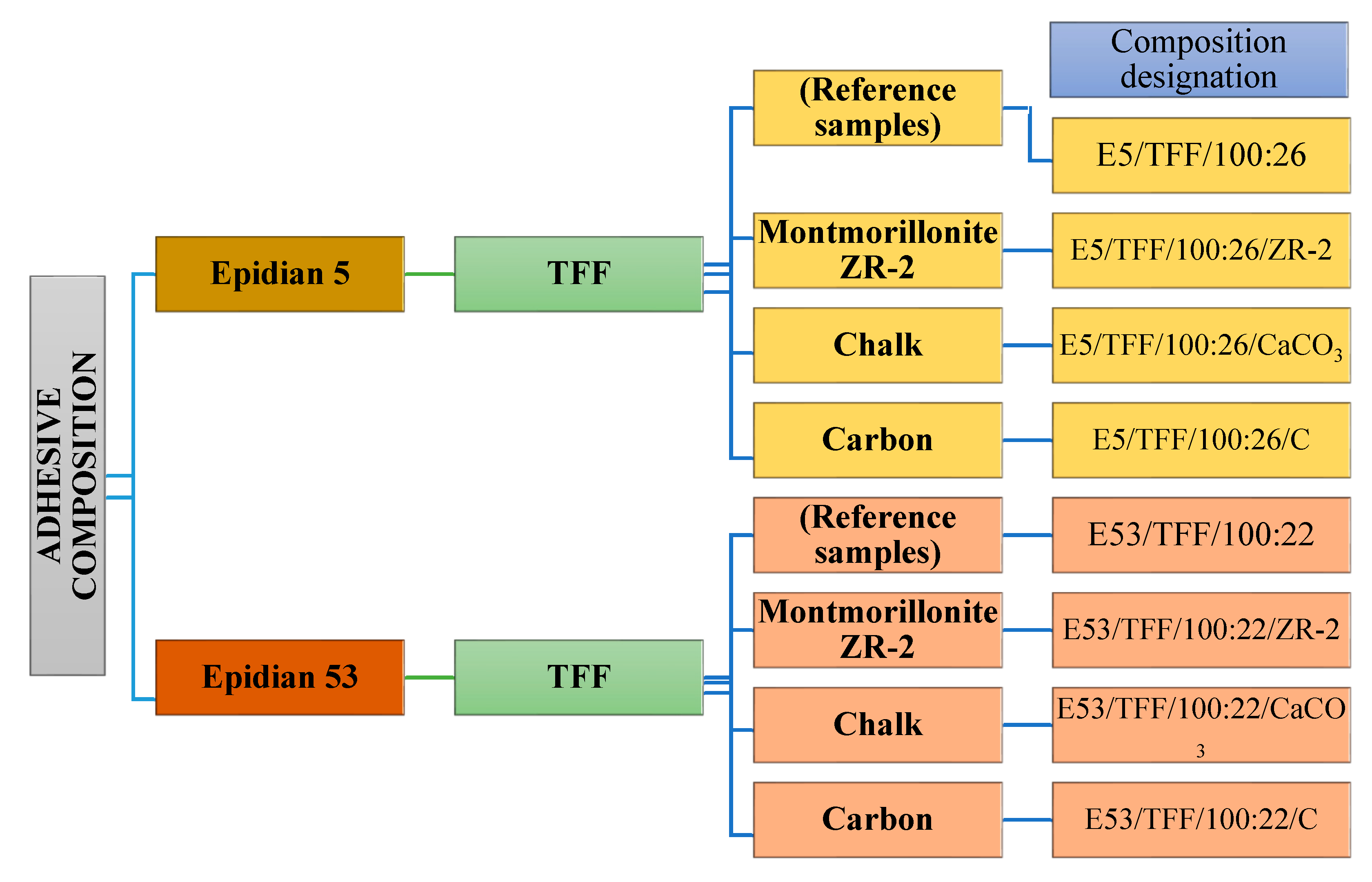
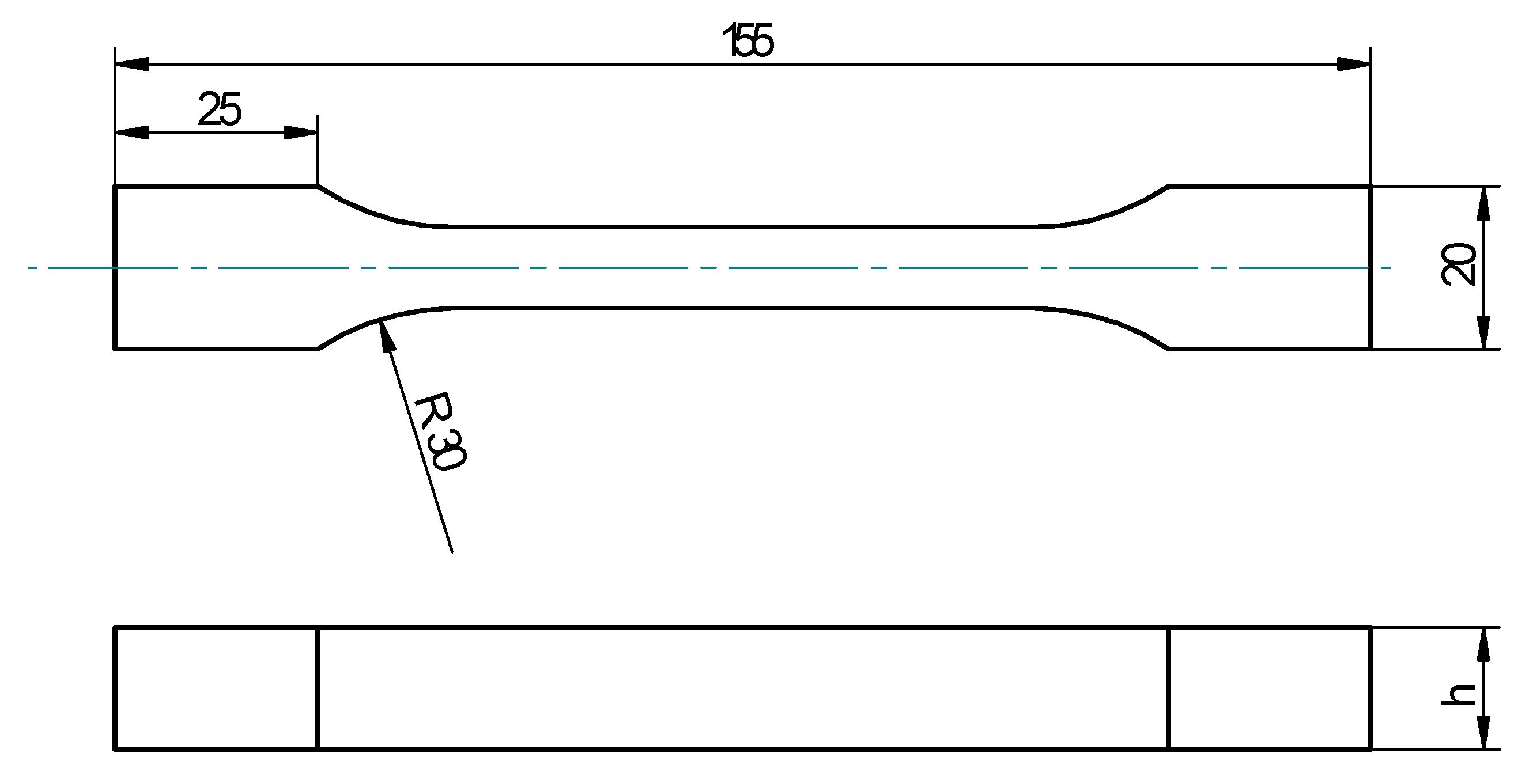
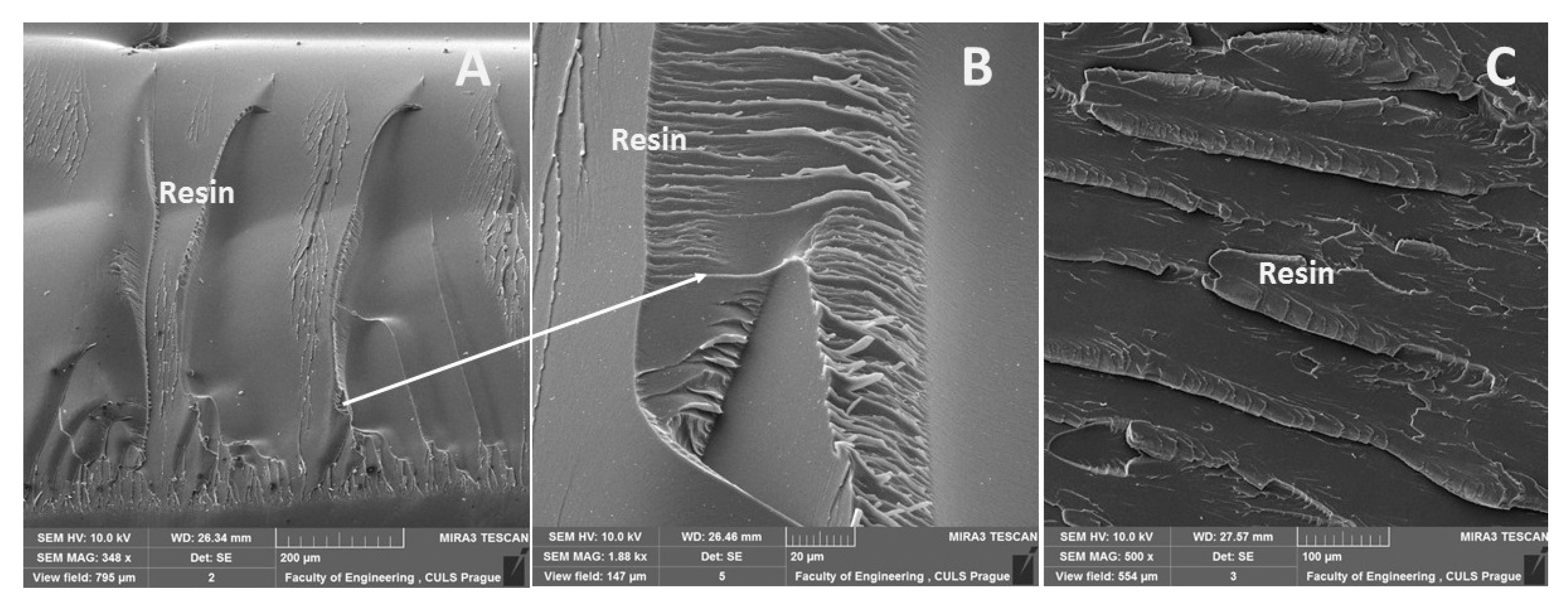
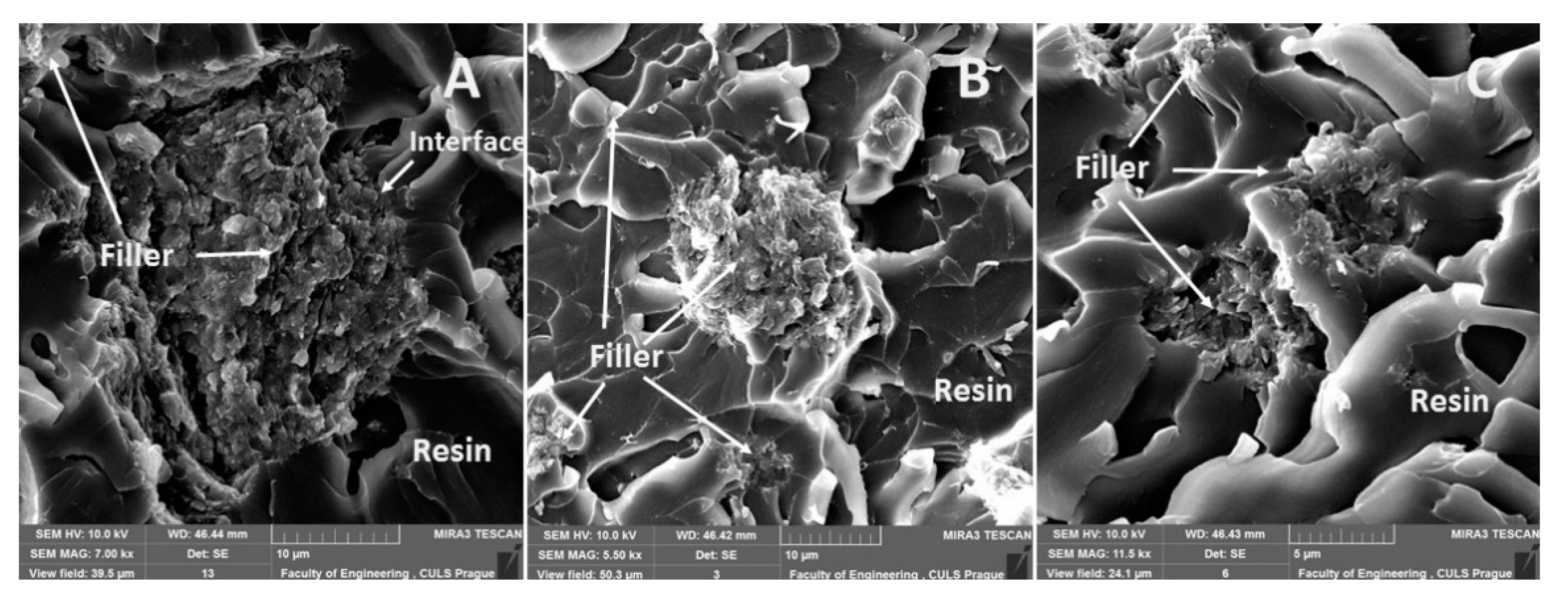
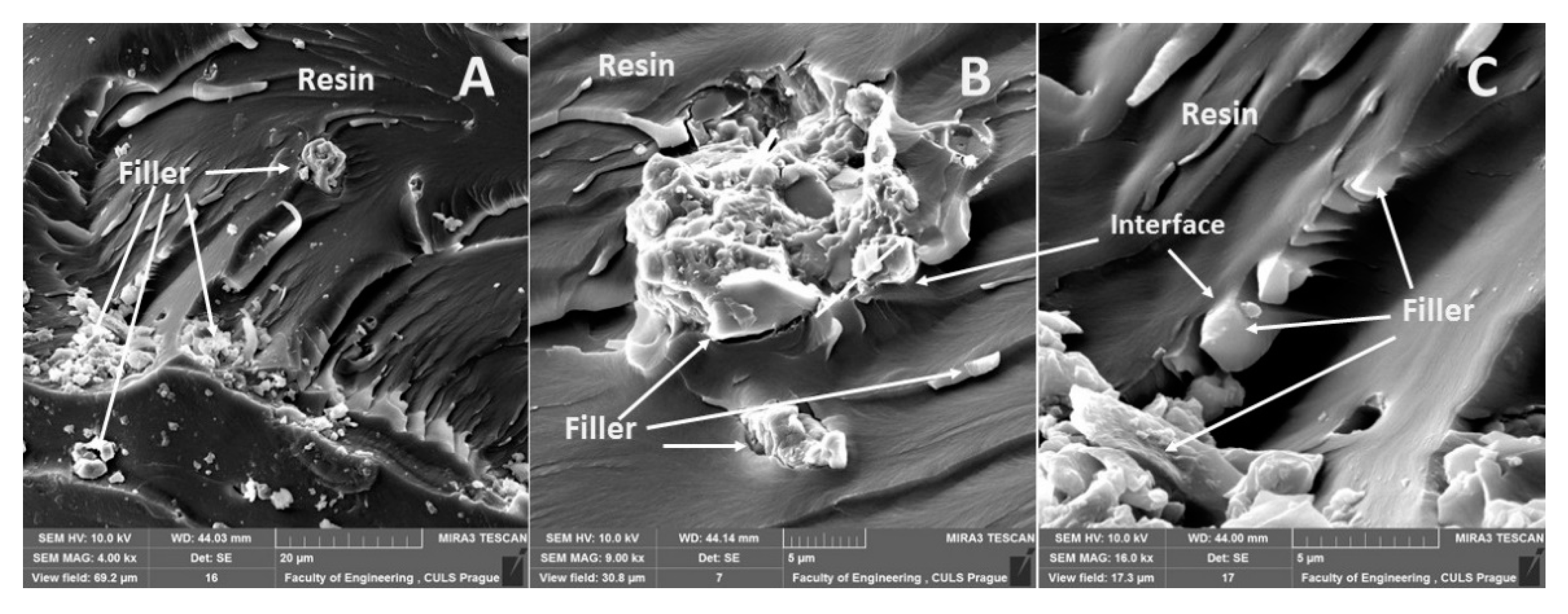
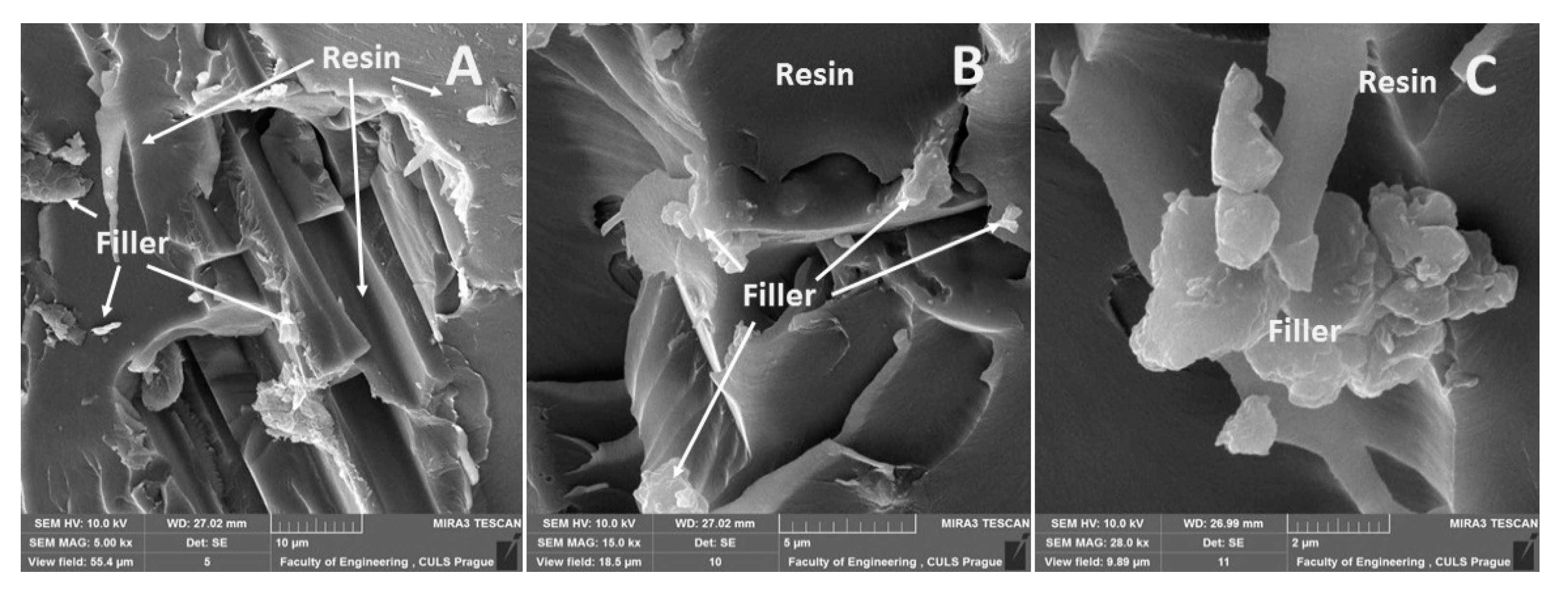
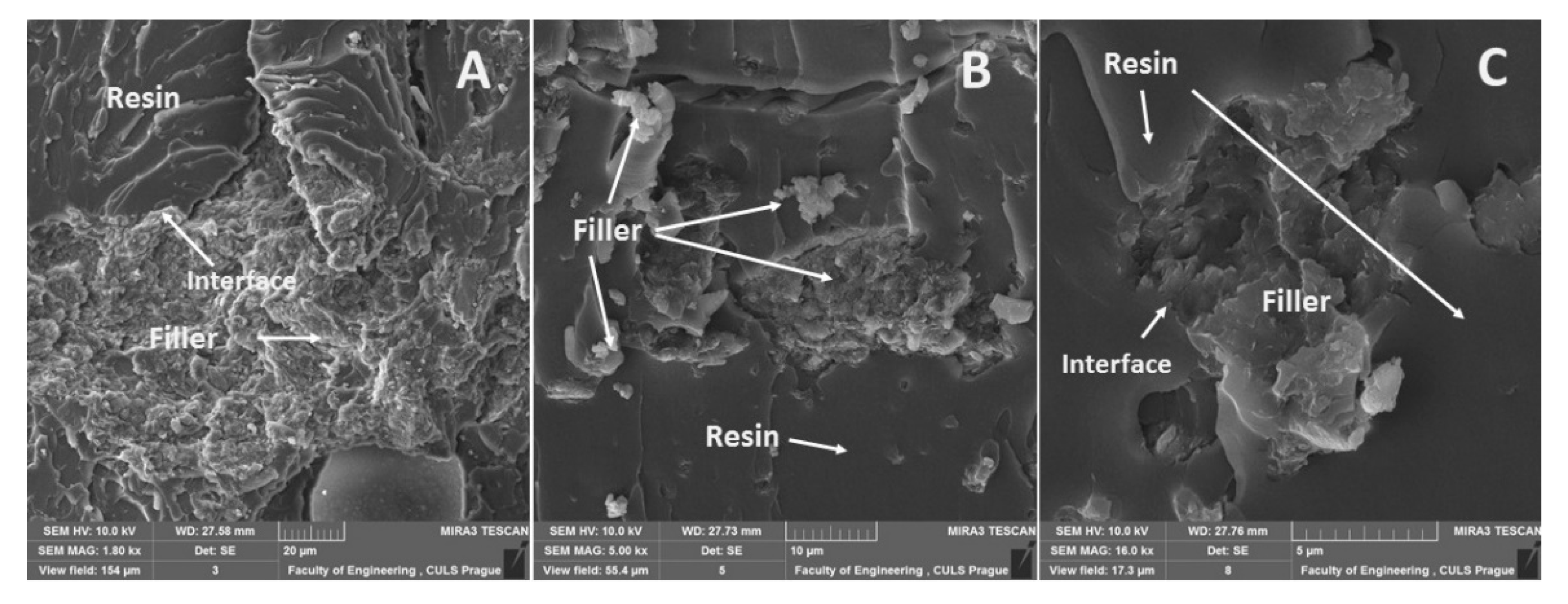
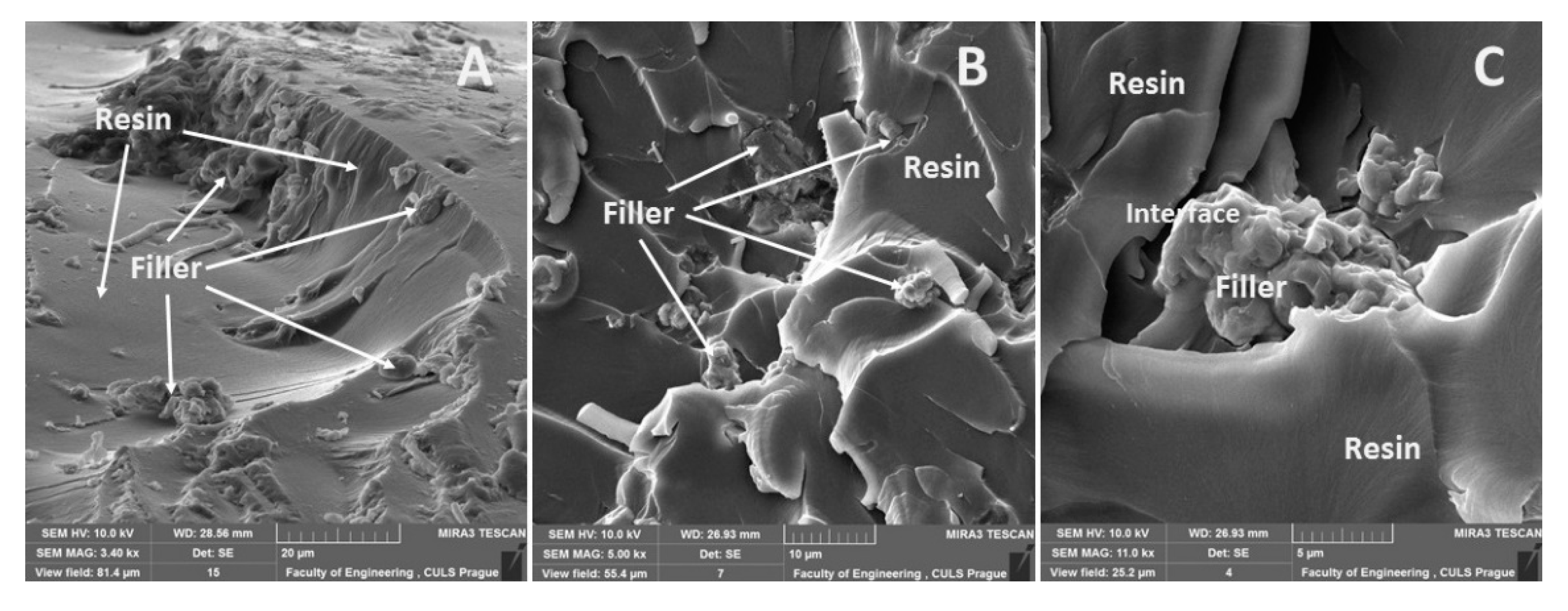
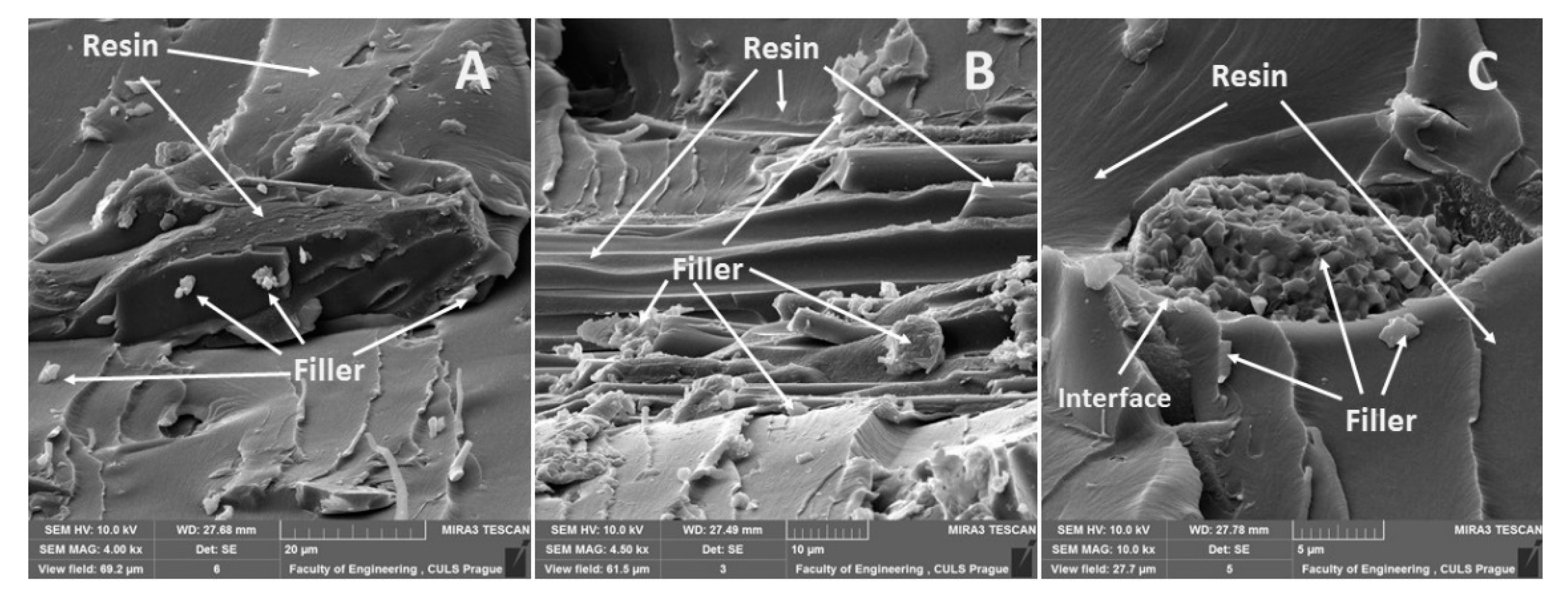
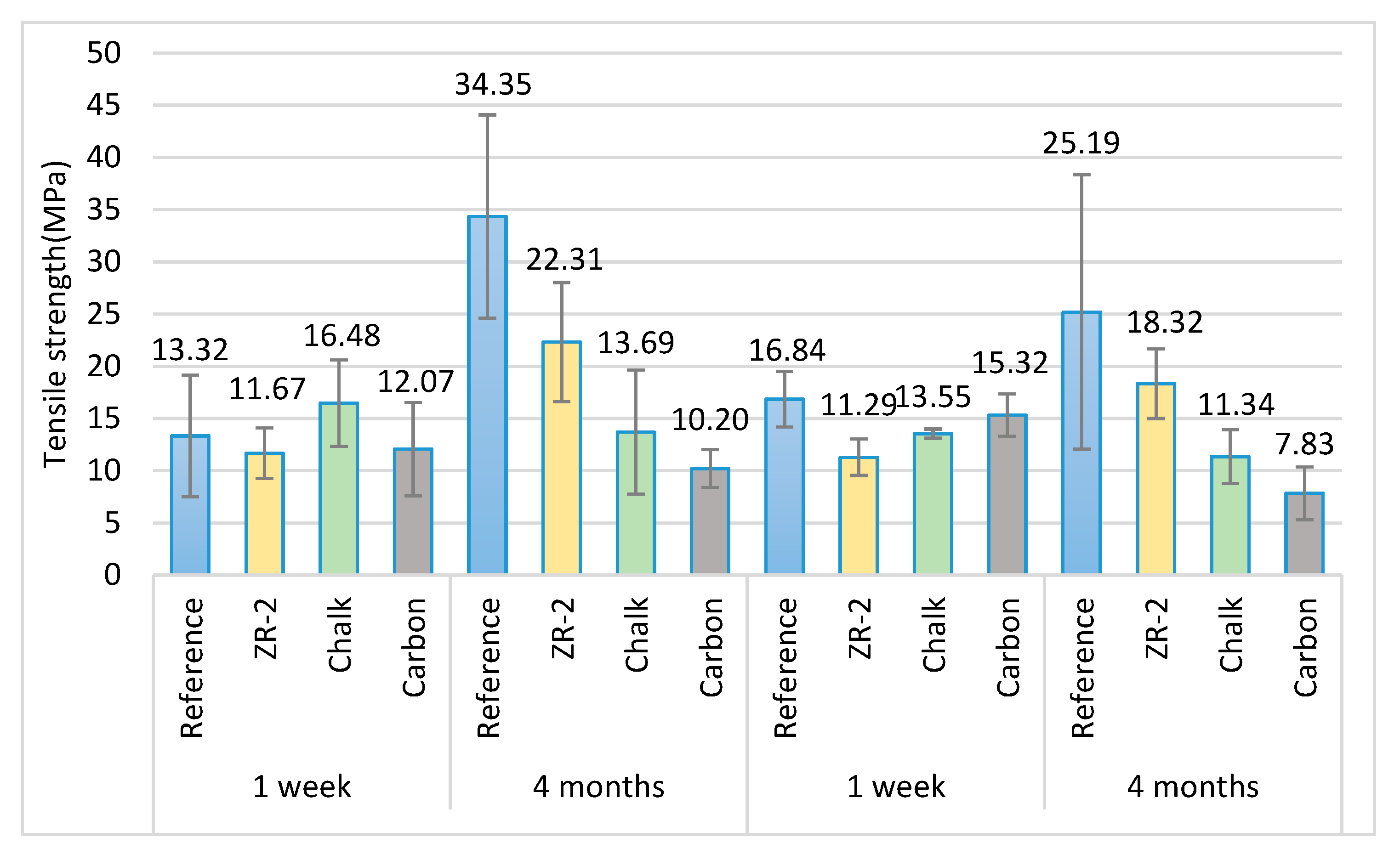
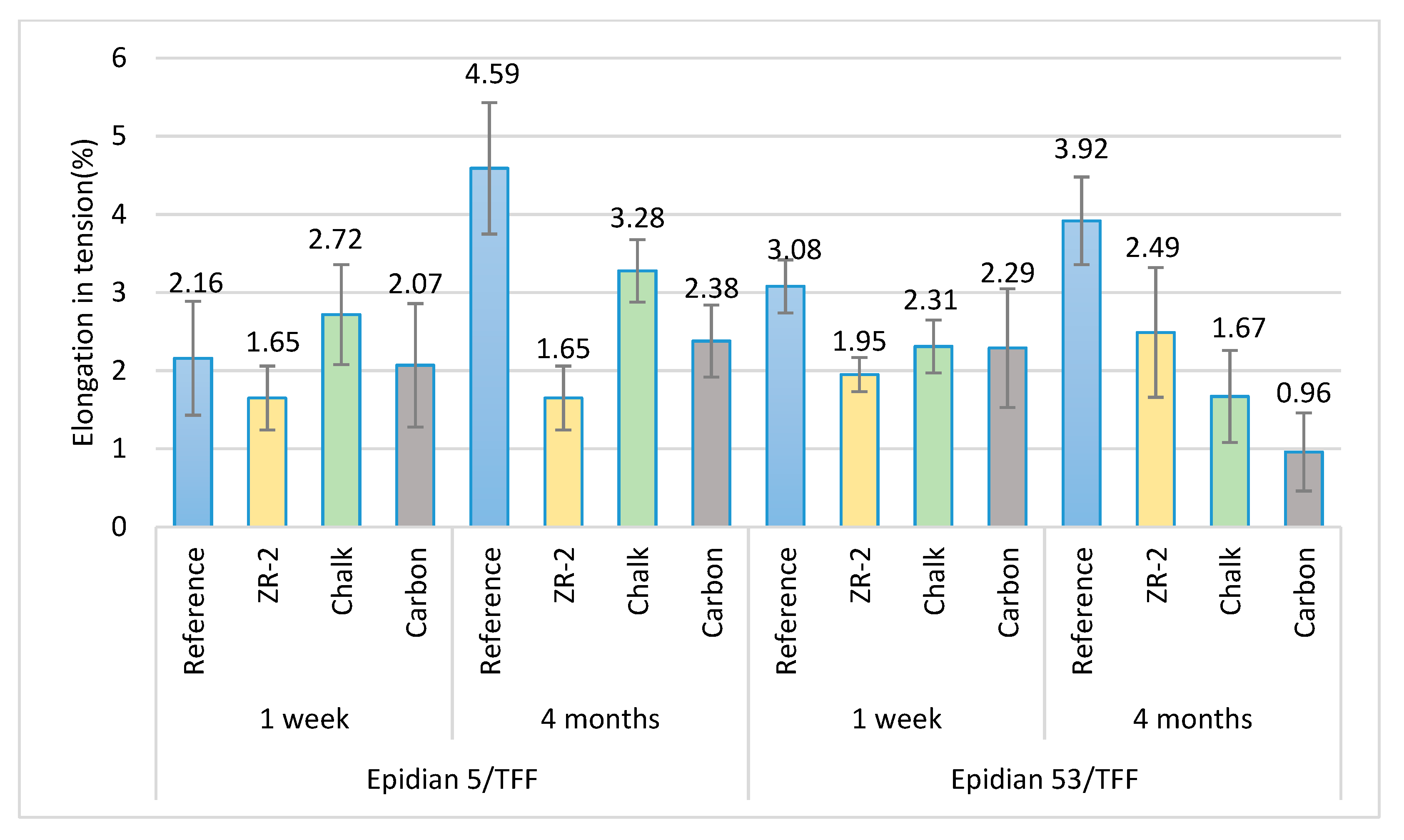
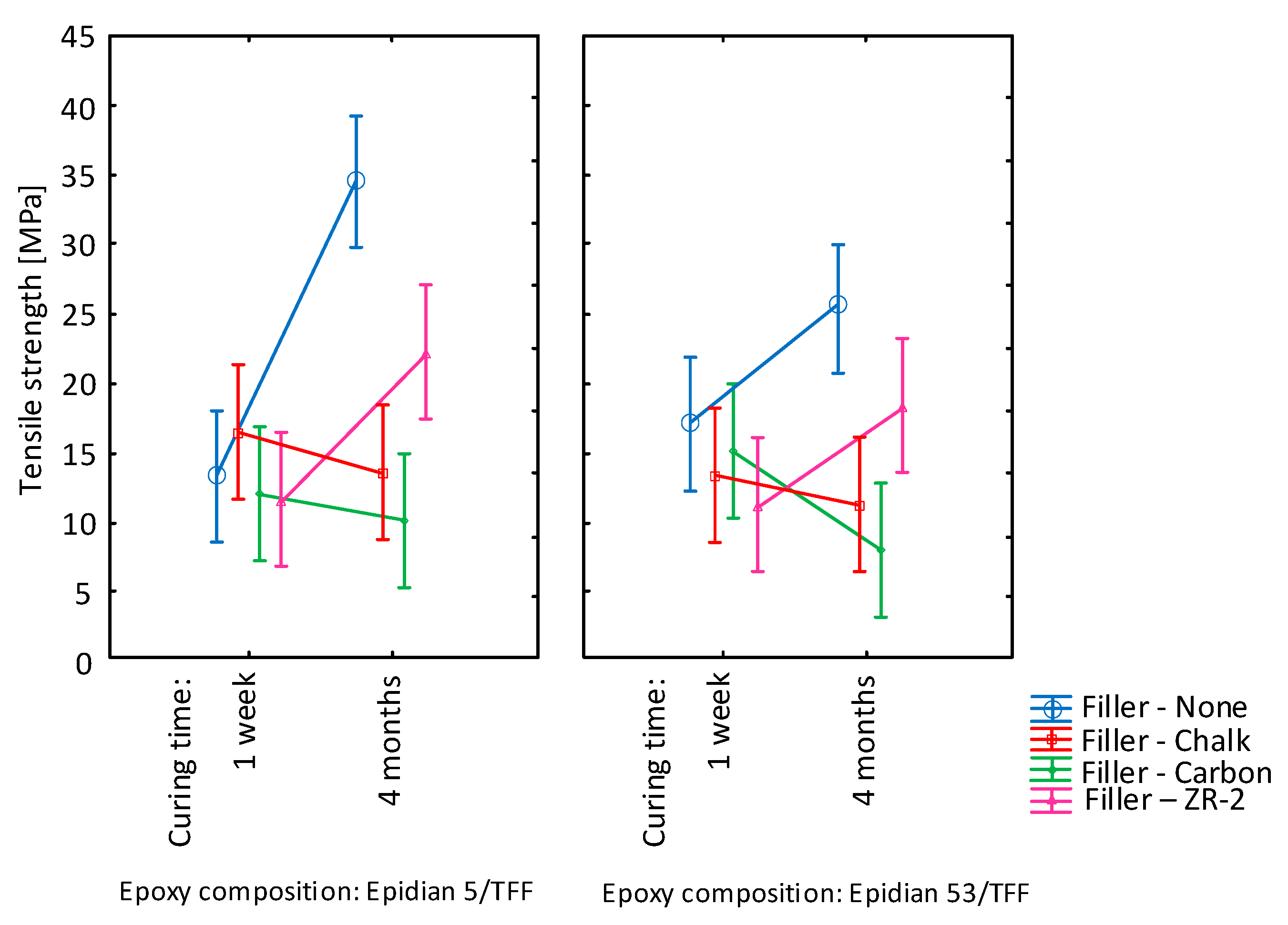
| Characteristics | Epidian 5 | Epidian 53 |
|---|---|---|
| Epoxide number (mol/100 g) | 0.48–0.52 | ≥0.41 |
| Adhesiveness in 25 °C (mPa·s) | 15,000–30,000 | 900–1500 |
| Epoxide Resin (100 g) | TFF Curing Agent Amount (g) |
|---|---|
| Epidian 5 | 26 |
| Epidian 53 | 22 |
| Characteristics | Montmorillonite NanoBent ZR-2 | Chalk | Activated Carbon |
|---|---|---|---|
| Type | Organic aluminosilicate | Inorganic chemical compound in the form of a sedimentary rock | Organic alkaline dust coal, made of charcoal activated with steam |
| Origin | Natural | Natural | Natural |
| Form | Light grey solid in the form of powder | White solid in the form of powder | Black powder in the fine crystalline form |
| Base | Modified by the quaternary ammonium salt | Limestone variety | Activated carbon |
| Density | <0.5 g/cm3 | 2.711 g/cm3 | 2 g/cm3 |
| Molecular formula | Mx(Al4−xMgj)(Si8)O20(OH)4 | CaCO3 | C |
| Epoxide Resin | Curing Agent | Filler | Curing Time | Seasoning Time | Designation of a Sample Group | Composition Designation |
|---|---|---|---|---|---|---|
| Epidian 5 | TFF | Reference samples | 7 days | - | E5/TFF/1 week | E5/TFF/100:26/1W |
| Montmorillonite ZR-2 | E5/TFF/100:26/ZR-2/1W | |||||
| Chalk CaCO3 | E5/TFF/100:26/CaCO3/1W | |||||
| Carbon C | E5/TFF/100:26/C/1W | |||||
| Epidian 53 | TFF | Reference samples | 7 days | - | E53/TFF/1 week | E53/TFF/100:22/1W |
| Montmorillonite ZR-2 | E53/TFF/100:22/ZR-2/1W | |||||
| Chalk CaCO3 | E53/TFF/100:22/CaCO3/1W | |||||
| Carbon C | E53/TFF/100:22/C/1W | |||||
| Epidian 5 | TFF | Reference samples | 7 days | 4 months | E5/TFF/4 months | E5/TFF/100:26/4M |
| Montmorillonite ZR-2 | E5/TFF/100:26/ZR-2/4M | |||||
| Chalk CaCO3 | E5/TFF/100:26/CaCO3/4M | |||||
| Carbon C | E5/TFF/100:26/C/4M | |||||
| Epidian 53 | TFF | Reference samples | 7 days | 4 months | E53/TFF/4 months | E53/TFF/100:22/4M |
| Montmorillonite ZR-2 | E53/TFF/100:22/ZR-2/4M | |||||
| Chalk CaCO3 | E53/TFF/100:22/CaCO3/4M | |||||
| Carbon C | E53/TFF/100:22/C/4M |
| Adhesive Composition | Maximum Force (N) | Tensile Strength (MPa) | Elongation in Tension (%) | |
|---|---|---|---|---|
| Mean | Mean | Mean | ||
| E5/TFF/100:26/1W | {1} | 1923.6 ± 1055.1 | 13.32 ± 5.82 | 2.16 ± 0.73 |
| E5/TFF/100:26/ZR-2/1W | {2} | 1723.9 ± 525.5 | 11.67 ± 2.42 | 1.65 ± 0.41 |
| E5/TFF/100:26/CaCO3/1W | {3} | 2219.3 ± 608.6 | 16.48 ± 4.14 | 2.72 ± 0.64 |
| E5/TFF/100:26/C/1W | {4} | 1640.2 ± 635.9 | 12.07 ± 4.46 | 2.07 ± 0.79 |
| Adhesive Composition | Tested Group; M—Mean | ||||
|---|---|---|---|---|---|
| {1} M = 13.32 | {2} M = 11.67 | {3} M = 16.48 | {4} M = 12.07 | ||
| E5/TFF/100:26/1W | {1} | 0.931782 | 0.671683 | 0.968197 | |
| E5/TFF/100:26/ZR-2/1W | {2} | 0.931782 | 0.338717 | 0.998947 | |
| E5/TFF/100:26/CaCO3/1W | {3} | 0.671683 | 0.338717 | 0.410581 | |
| E5/TFF/100:26/C/1W | {4} | 0.968197 | 0.998947 | 0.410581 | |
| Adhesive Composition | Maximum Force (N) | Tensile Strength (MPa) | Elongation in Tension (%) | |
|---|---|---|---|---|
| Mean | Mean | Mean | ||
| E53/TFF/100:22/1W | {1} | 2289.1 ± 303.6 | 16.84 ± 2.66 | 3.08 ± 0.34 |
| E53/TFF/100:22/ZR-2/1W | {2} | 1432.5 ± 76.7 | 11.29 ± 1.75 | 1.95 ± 0.22 |
| E53/TFF/100:22/CaCO3/1W | {3} | 1987.1 ± 119.5 | 13.55 ± 0.44 | 2.31 ± 0.34 |
| E53/TFF/100:22/C/1W | {4} | 2149.1 ± 174.5 | 15.32 ± 2.03 | 2.29 ± 0.76 |
| Adhesive Composition | Tested Group | ||||
|---|---|---|---|---|---|
| {1} M = 16.84 | {2} M = 11.29 | {3} M = 13.55 | {4} M = 15.32 | ||
| E53/TFF/100:22/1W | {1} | 0.002514 | 0.222613 | 1.000000 | |
| E53/TFF/100:22/ZR-2/1W | {2} | 0.002514 | 0.893767 | 0.052888 | |
| E53/TFF/100:22/CaCO3/1W | {3} | 0.222613 | 0.893767 | 1.000000 | |
| E53/TFF/100:22/C/1W | {4} | 1.000000 | 0.052888 | 1.000000 | |
| Adhesive Composition | Maximum Force (N) | Tensile Strength (MPa) | Elongation in Tension (%) | |
|---|---|---|---|---|
| Mean | Mean | Mean | ||
| E5/TFF/100:26/4M | {1} | 4760.7 ± 1163.7 | 34.35 ± 9.72 | 4.59 ± 0.84 |
| E5/TFF/100:26/ZR-2/4M | {2} | 3175.9 ± 928.0 | 22.31 ± 5.71 | 1.65 ± 0.41 |
| E5/TFF/100:26/CaCO3/4M | {3} | 1633.0 ± 668.8 | 13.69 ± 5.93 | 3.28 ± 0.40 |
| E5/TFF/100:26/C/4M | {4} | 1354.3 ± 196.6 | 10.20 ± 1.83 | 2.38 ± 0.46 |
| Adhesive Composition | Tested Group; M—Mean | ||||
|---|---|---|---|---|---|
| {1} M = 34.35 | {2} M = 22.31 | {3} M = 13.69 | {4} M = 10.20 | ||
| E5/TFF/100:26/4M | {1} | 1.000000 | 0.045158 | 0.005518 | |
| E5/TFF/100:26/ZR-2/4M | {2} | 1.000000 | 0.523072 | 0.112067 | |
| E5/TFF/100:26/ CaCO3/4M | {3} | 0.045158 | 0.523072 | 1.000000 | |
| E5/TFF/100:26/C/4M | {4} | 0.005518 | 0.112067 | 1.000000 | |
| Adhesive Composition | Maximum Force (N) | Tensile Strength (MPa) | Elongation in Tension (%) | |
|---|---|---|---|---|
| Mean | Mean | Mean | ||
| E53/TFF/100:22/4M | {1} | 3299.7 ± 1671.5 | 25.19 ± 13.14 | 3.92 ± 0.56 |
| E53/TFF/100:22/ZR-2/4M | {2} | 1986.2 ± 394.8 | 18.32 ± 3.33 | 2.49 ± 0.83 |
| E53/TFF/100:22/CaCO3/4M | {3} | 1555.5 ± 357.7 | 11.34 ± 2.56 | 1.67 ± 0.59 |
| E53/TFF/100:22/C/4M | {4} | 961.6 ± 281.3 | 7.83 ± 2.53 | 0.96 ± 0.50 |
| Adhesive Composition | Tested Group; M—Mean | ||||
|---|---|---|---|---|---|
| {1} M = 25.19 | {2} M = 18.32 | {3} M = 11.34 | {4} M = 7.83 | ||
| E53/TFF/100:22/4M | {1} | 1.000000 | 0.726683 | 0.032664 | |
| E53/TFF/100:22/C/4M | {2} | 1.000000 | 0.806886 | 0.038457 | |
| E53/TFF/100:22/ZR-2/4M | {3} | 0.726683 | 0.806886 | 1.000000 | |
| E53/TFF/100:22/CaCO3/4M | {4} | 0.032664 | 0.038457 | 1.000000 | |
© 2020 by the authors. Licensee MDPI, Basel, Switzerland. This article is an open access article distributed under the terms and conditions of the Creative Commons Attribution (CC BY) license (http://creativecommons.org/licenses/by/4.0/).
Share and Cite
Miturska, I.; Rudawska, A.; Müller, M.; Valášek, P. The Influence of Modification with Natural Fillers on the Mechanical Properties of Epoxy Adhesive Compositions after Storage Time. Materials 2020, 13, 291. https://doi.org/10.3390/ma13020291
Miturska I, Rudawska A, Müller M, Valášek P. The Influence of Modification with Natural Fillers on the Mechanical Properties of Epoxy Adhesive Compositions after Storage Time. Materials. 2020; 13(2):291. https://doi.org/10.3390/ma13020291
Chicago/Turabian StyleMiturska, Izabela, Anna Rudawska, Miroslav Müller, and Petr Valášek. 2020. "The Influence of Modification with Natural Fillers on the Mechanical Properties of Epoxy Adhesive Compositions after Storage Time" Materials 13, no. 2: 291. https://doi.org/10.3390/ma13020291
APA StyleMiturska, I., Rudawska, A., Müller, M., & Valášek, P. (2020). The Influence of Modification with Natural Fillers on the Mechanical Properties of Epoxy Adhesive Compositions after Storage Time. Materials, 13(2), 291. https://doi.org/10.3390/ma13020291






